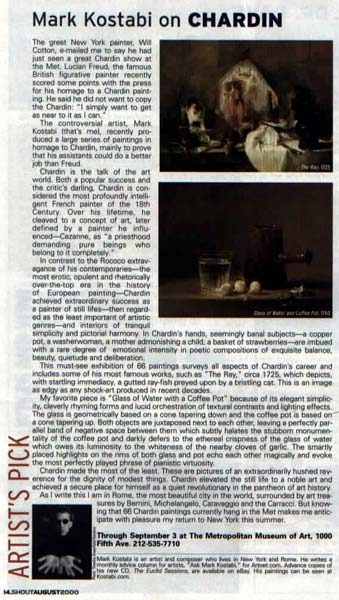Mark Kostabi on Chardin

The great New York painter, Will Cotton, e-mailed me to say he had just seen a great Chardin show at the Met. Lucian Freud, the famous British figurative painter, recently scored some points with the press for his homage to a Chardin painting. He said he did not want to copy the Chardin: “I simply want to get as near to it as I can.”
The controversial artist, Mark Kostabi (that’s me), recently produced a large series of paintings in homage to Chardin, mainly to prove that his assistants could do a better job than Freud.
Chardin is the talk of the art world. Both a popular success and the critic’s darling, Chardin is considered the most profoundly intelligent French painter of the 18th century. Over his lifetime, he cleaved to a concept of art, later defined by a painter he influenced—Cezanne, as “a priesthood demanding pure beings who belong to it completely.”
In contrast to the Rococo extravagance of his contemporaries—the most erotic, opulent and rhetorically over-the-top era in the history of European painting—Chardin achieved extraordinary success as a painter of still lifes—then regarded as the least important of artistic genres—and interiors of tranquil simplicity and pictorial harmony. In Chardin’s hands, seemingly banal subjects—a copper pot, a washerwoman, a mother admonishing a child, a basket of strawberries—are imbued with a rare degree of emotional intensity in poetic compositions of exquisite balance, beauty, quietude and deliberation.
This must-see exhibition of 66 paintings surveys all aspects Chardin’s career and includes some of his most famous works, such as “The Ray,” circa 1725, which depicts, with startling immediacy, a gutted ray-fish preyed upon by a bristling cat. This is an image as edgy as any shock-art produced in recent decades.
My favorite piece is “Glass of Water with a Coffee Pot” because of its elegant simplicity, cleverly rhyming forms and lucid orchestration of textural contrasts and lighting effects. The glass is geometrically based on a cone tapering down ant the coffee pot is based on a cone tapering up. Both objects are juxtaposed next to each other, leaving perfectly parallel band of negative space between them which subtly highlights the stubborn monumentality of the coffee pot and darkly defers to the ethereal crispness of the glass of water which owes its luminosity to the whiteness of the nearby cloves of garlic. The smartly placed highlights on the rims of both glass and pot echo each other magically and evoke the most perfectly played phrase of pianistic virtuosity.
Chardin made the most of the least. These are pictures of an extraordinarily hushed reverence for the dignity of modest things. Chardin elevated the still life to a noble art and achieved a secure place for himself as a quiet revolutionary in the pantheon of art history.
As I write this I am in Rome, the most beautiful city in the world, surrounded by art treasures by Bernini, Michelangelo, Caravaggio and the Carracci. But knowing that 66 Chardin paintings currently hang in the Met makes me anticipate with pleasure my return to New York the summer.
August 2000